Bow Valley College MGMT1101: Research and Analysis Paper – Part II
VerifiedAdded on 2023/01/18
|11
|2279
|63
Project
AI Summary
This research and analysis paper, focusing on Tim Hortons, examines its internal and external environments, stakeholders, and organizational structure within the context of the Canadian market. The paper presents a SWOT analysis, highlighting the company's strengths, weaknesses, opportunities, and threats, and formulates strategies based on these factors. It also analyzes the environmental constraints, including political, economic, socio-cultural, technological, environmental, and legal aspects impacting Tim Hortons' operations. The stakeholders, including employees, customers, investors, and suppliers, are prioritized, and the organizational structure is presented with an emphasis on its mechanistic design. The paper further explores employee motivation using Maslow's hierarchy of needs and provides recommendations for improvement, including a focus on expanding offerings and implementing control mechanisms like feedback and quality parameters. References are provided for further reading.
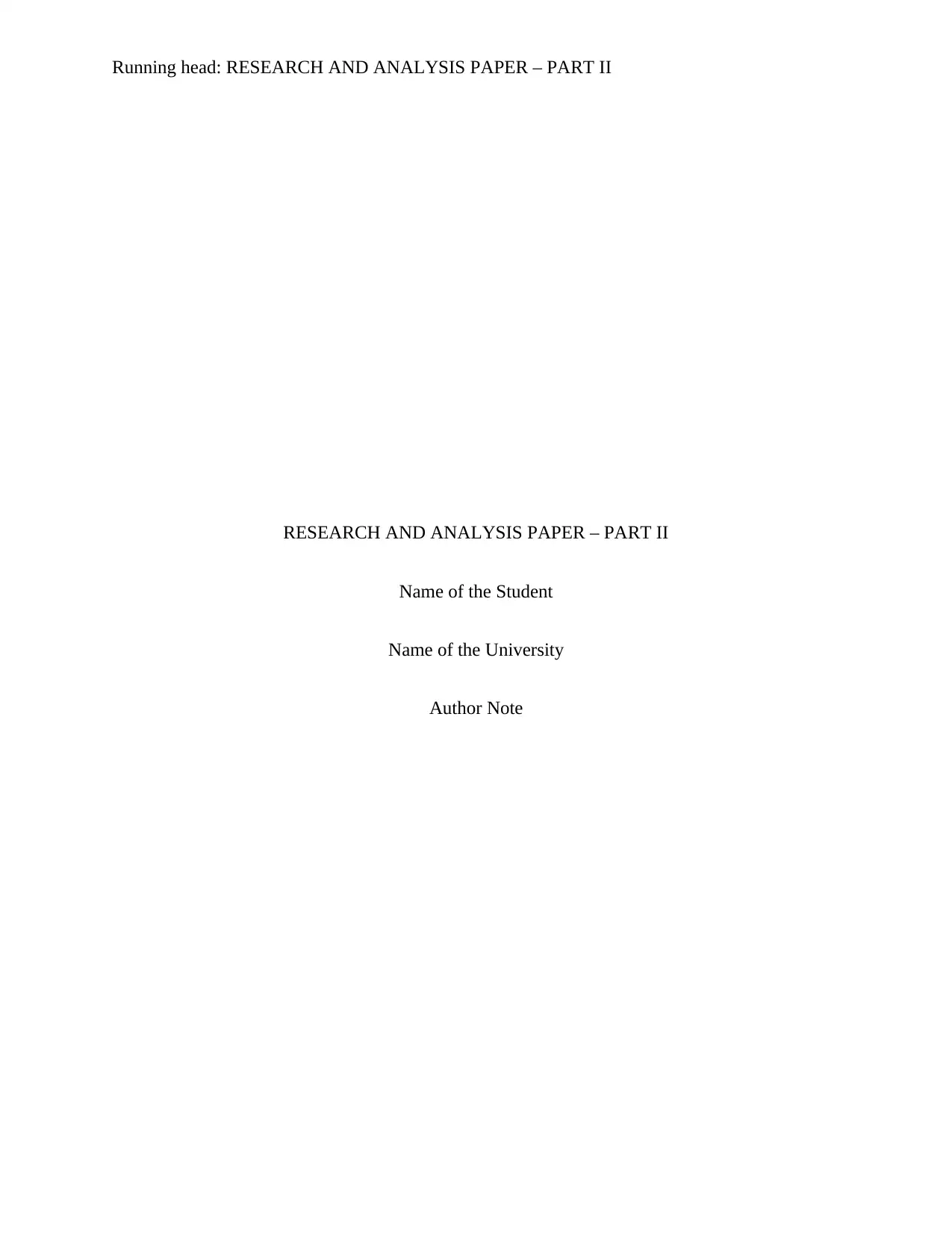
Running head: RESEARCH AND ANALYSIS PAPER – PART II
RESEARCH AND ANALYSIS PAPER – PART II
Name of the Student
Name of the University
Author Note
RESEARCH AND ANALYSIS PAPER – PART II
Name of the Student
Name of the University
Author Note
Paraphrase This Document
Need a fresh take? Get an instant paraphrase of this document with our AI Paraphraser
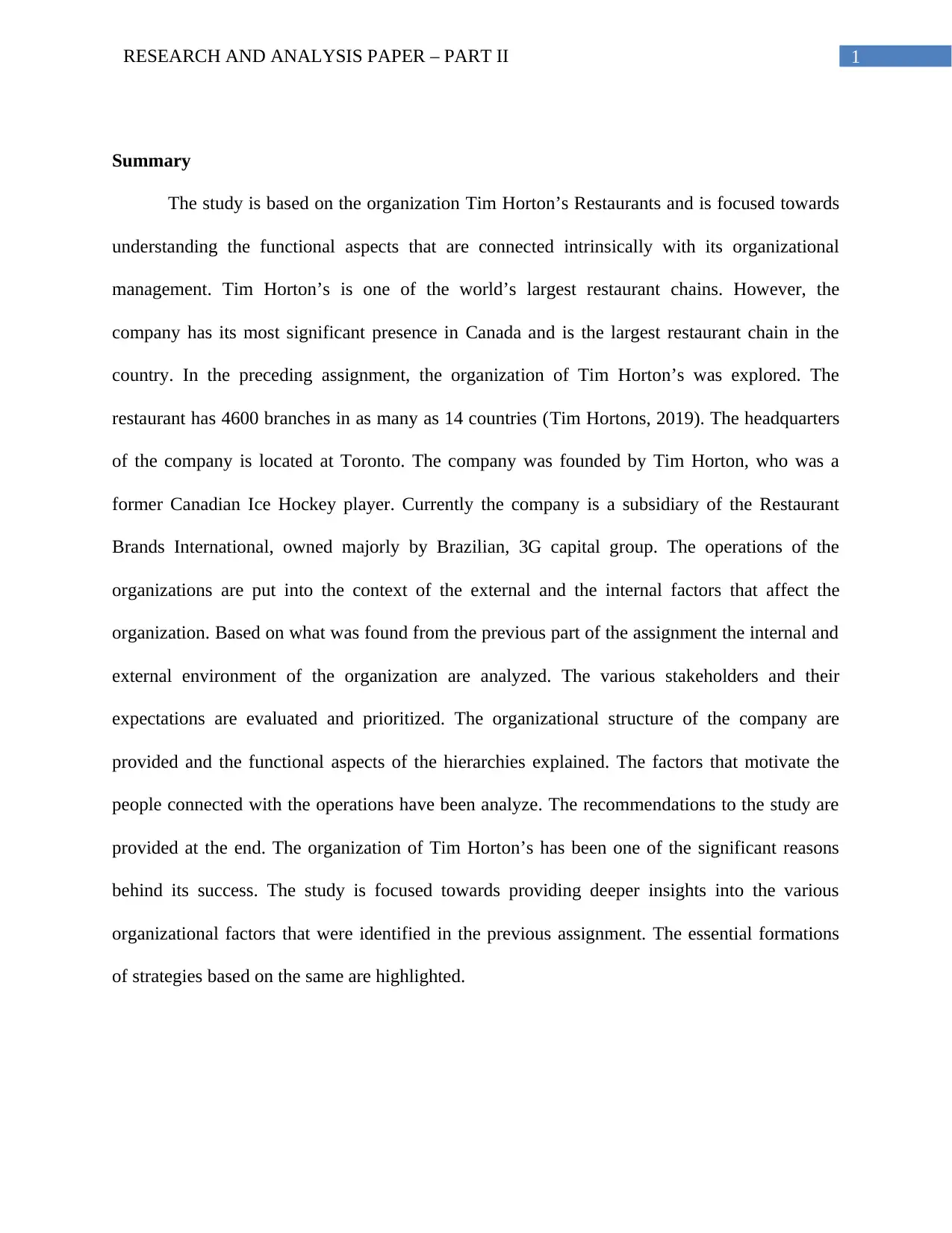
1RESEARCH AND ANALYSIS PAPER – PART II
Summary
The study is based on the organization Tim Horton’s Restaurants and is focused towards
understanding the functional aspects that are connected intrinsically with its organizational
management. Tim Horton’s is one of the world’s largest restaurant chains. However, the
company has its most significant presence in Canada and is the largest restaurant chain in the
country. In the preceding assignment, the organization of Tim Horton’s was explored. The
restaurant has 4600 branches in as many as 14 countries (Tim Hortons, 2019). The headquarters
of the company is located at Toronto. The company was founded by Tim Horton, who was a
former Canadian Ice Hockey player. Currently the company is a subsidiary of the Restaurant
Brands International, owned majorly by Brazilian, 3G capital group. The operations of the
organizations are put into the context of the external and the internal factors that affect the
organization. Based on what was found from the previous part of the assignment the internal and
external environment of the organization are analyzed. The various stakeholders and their
expectations are evaluated and prioritized. The organizational structure of the company are
provided and the functional aspects of the hierarchies explained. The factors that motivate the
people connected with the operations have been analyze. The recommendations to the study are
provided at the end. The organization of Tim Horton’s has been one of the significant reasons
behind its success. The study is focused towards providing deeper insights into the various
organizational factors that were identified in the previous assignment. The essential formations
of strategies based on the same are highlighted.
Summary
The study is based on the organization Tim Horton’s Restaurants and is focused towards
understanding the functional aspects that are connected intrinsically with its organizational
management. Tim Horton’s is one of the world’s largest restaurant chains. However, the
company has its most significant presence in Canada and is the largest restaurant chain in the
country. In the preceding assignment, the organization of Tim Horton’s was explored. The
restaurant has 4600 branches in as many as 14 countries (Tim Hortons, 2019). The headquarters
of the company is located at Toronto. The company was founded by Tim Horton, who was a
former Canadian Ice Hockey player. Currently the company is a subsidiary of the Restaurant
Brands International, owned majorly by Brazilian, 3G capital group. The operations of the
organizations are put into the context of the external and the internal factors that affect the
organization. Based on what was found from the previous part of the assignment the internal and
external environment of the organization are analyzed. The various stakeholders and their
expectations are evaluated and prioritized. The organizational structure of the company are
provided and the functional aspects of the hierarchies explained. The factors that motivate the
people connected with the operations have been analyze. The recommendations to the study are
provided at the end. The organization of Tim Horton’s has been one of the significant reasons
behind its success. The study is focused towards providing deeper insights into the various
organizational factors that were identified in the previous assignment. The essential formations
of strategies based on the same are highlighted.
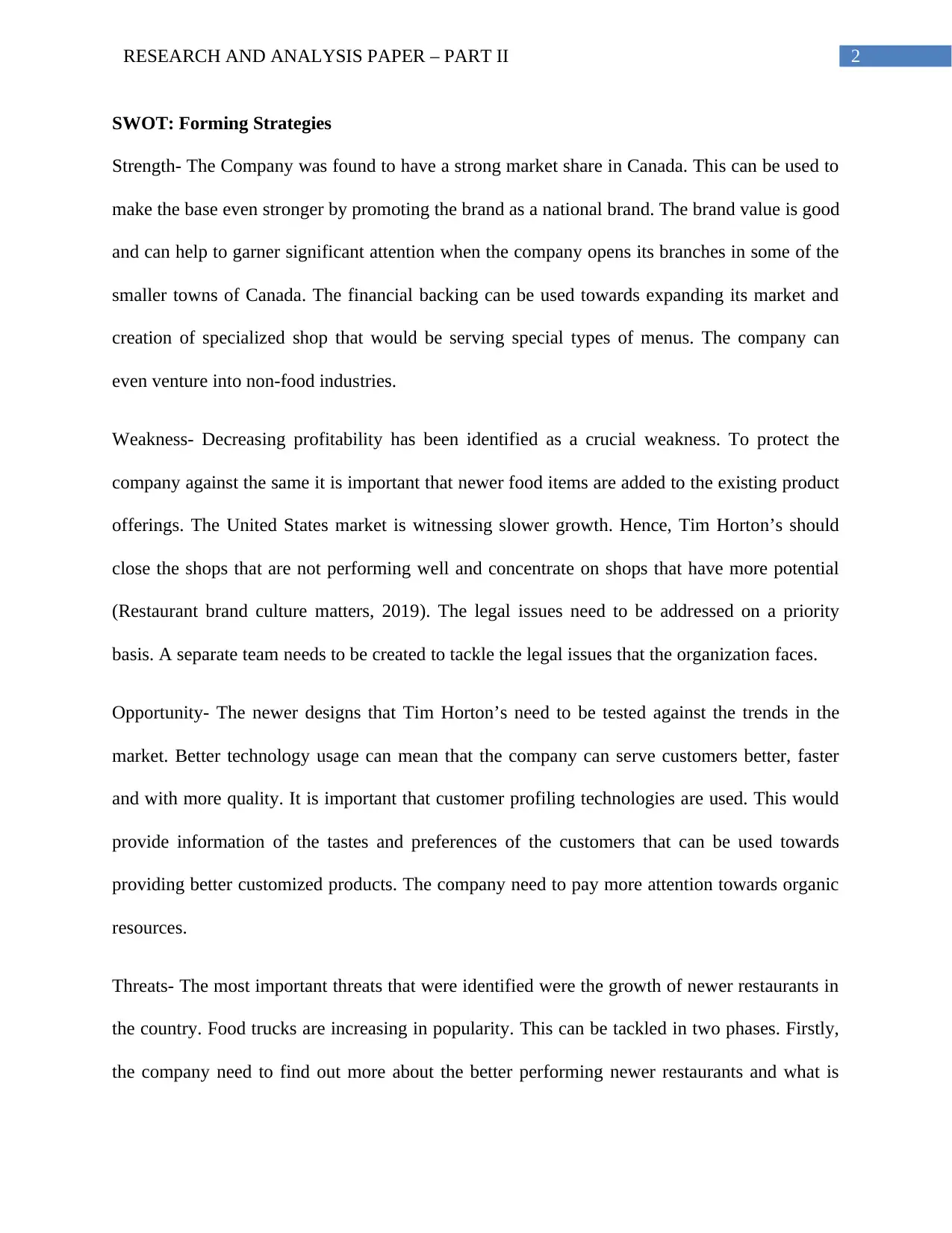
2RESEARCH AND ANALYSIS PAPER – PART II
SWOT: Forming Strategies
Strength- The Company was found to have a strong market share in Canada. This can be used to
make the base even stronger by promoting the brand as a national brand. The brand value is good
and can help to garner significant attention when the company opens its branches in some of the
smaller towns of Canada. The financial backing can be used towards expanding its market and
creation of specialized shop that would be serving special types of menus. The company can
even venture into non-food industries.
Weakness- Decreasing profitability has been identified as a crucial weakness. To protect the
company against the same it is important that newer food items are added to the existing product
offerings. The United States market is witnessing slower growth. Hence, Tim Horton’s should
close the shops that are not performing well and concentrate on shops that have more potential
(Restaurant brand culture matters, 2019). The legal issues need to be addressed on a priority
basis. A separate team needs to be created to tackle the legal issues that the organization faces.
Opportunity- The newer designs that Tim Horton’s need to be tested against the trends in the
market. Better technology usage can mean that the company can serve customers better, faster
and with more quality. It is important that customer profiling technologies are used. This would
provide information of the tastes and preferences of the customers that can be used towards
providing better customized products. The company need to pay more attention towards organic
resources.
Threats- The most important threats that were identified were the growth of newer restaurants in
the country. Food trucks are increasing in popularity. This can be tackled in two phases. Firstly,
the company need to find out more about the better performing newer restaurants and what is
SWOT: Forming Strategies
Strength- The Company was found to have a strong market share in Canada. This can be used to
make the base even stronger by promoting the brand as a national brand. The brand value is good
and can help to garner significant attention when the company opens its branches in some of the
smaller towns of Canada. The financial backing can be used towards expanding its market and
creation of specialized shop that would be serving special types of menus. The company can
even venture into non-food industries.
Weakness- Decreasing profitability has been identified as a crucial weakness. To protect the
company against the same it is important that newer food items are added to the existing product
offerings. The United States market is witnessing slower growth. Hence, Tim Horton’s should
close the shops that are not performing well and concentrate on shops that have more potential
(Restaurant brand culture matters, 2019). The legal issues need to be addressed on a priority
basis. A separate team needs to be created to tackle the legal issues that the organization faces.
Opportunity- The newer designs that Tim Horton’s need to be tested against the trends in the
market. Better technology usage can mean that the company can serve customers better, faster
and with more quality. It is important that customer profiling technologies are used. This would
provide information of the tastes and preferences of the customers that can be used towards
providing better customized products. The company need to pay more attention towards organic
resources.
Threats- The most important threats that were identified were the growth of newer restaurants in
the country. Food trucks are increasing in popularity. This can be tackled in two phases. Firstly,
the company need to find out more about the better performing newer restaurants and what is
⊘ This is a preview!⊘
Do you want full access?
Subscribe today to unlock all pages.

Trusted by 1+ million students worldwide
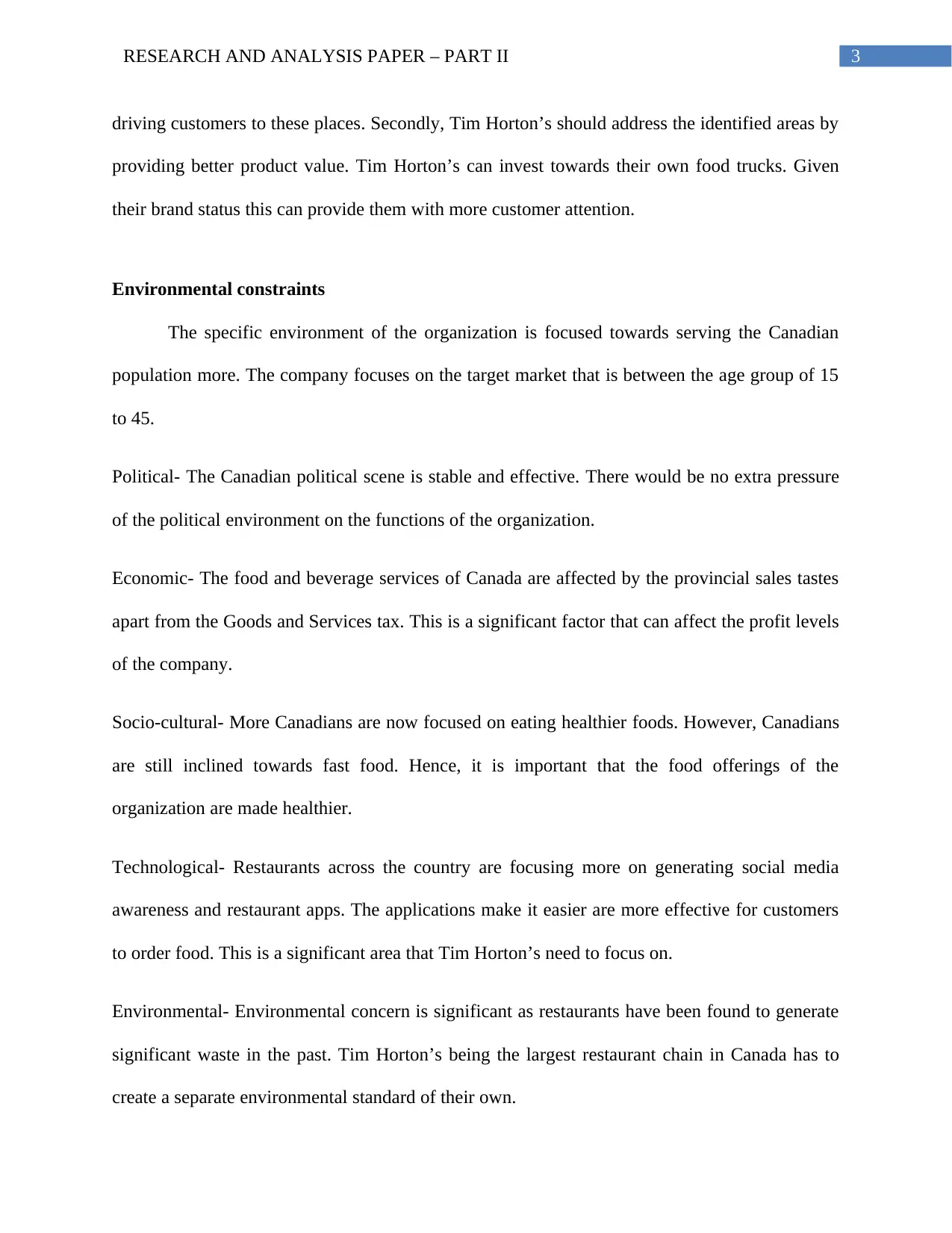
3RESEARCH AND ANALYSIS PAPER – PART II
driving customers to these places. Secondly, Tim Horton’s should address the identified areas by
providing better product value. Tim Horton’s can invest towards their own food trucks. Given
their brand status this can provide them with more customer attention.
Environmental constraints
The specific environment of the organization is focused towards serving the Canadian
population more. The company focuses on the target market that is between the age group of 15
to 45.
Political- The Canadian political scene is stable and effective. There would be no extra pressure
of the political environment on the functions of the organization.
Economic- The food and beverage services of Canada are affected by the provincial sales tastes
apart from the Goods and Services tax. This is a significant factor that can affect the profit levels
of the company.
Socio-cultural- More Canadians are now focused on eating healthier foods. However, Canadians
are still inclined towards fast food. Hence, it is important that the food offerings of the
organization are made healthier.
Technological- Restaurants across the country are focusing more on generating social media
awareness and restaurant apps. The applications make it easier are more effective for customers
to order food. This is a significant area that Tim Horton’s need to focus on.
Environmental- Environmental concern is significant as restaurants have been found to generate
significant waste in the past. Tim Horton’s being the largest restaurant chain in Canada has to
create a separate environmental standard of their own.
driving customers to these places. Secondly, Tim Horton’s should address the identified areas by
providing better product value. Tim Horton’s can invest towards their own food trucks. Given
their brand status this can provide them with more customer attention.
Environmental constraints
The specific environment of the organization is focused towards serving the Canadian
population more. The company focuses on the target market that is between the age group of 15
to 45.
Political- The Canadian political scene is stable and effective. There would be no extra pressure
of the political environment on the functions of the organization.
Economic- The food and beverage services of Canada are affected by the provincial sales tastes
apart from the Goods and Services tax. This is a significant factor that can affect the profit levels
of the company.
Socio-cultural- More Canadians are now focused on eating healthier foods. However, Canadians
are still inclined towards fast food. Hence, it is important that the food offerings of the
organization are made healthier.
Technological- Restaurants across the country are focusing more on generating social media
awareness and restaurant apps. The applications make it easier are more effective for customers
to order food. This is a significant area that Tim Horton’s need to focus on.
Environmental- Environmental concern is significant as restaurants have been found to generate
significant waste in the past. Tim Horton’s being the largest restaurant chain in Canada has to
create a separate environmental standard of their own.
Paraphrase This Document
Need a fresh take? Get an instant paraphrase of this document with our AI Paraphraser
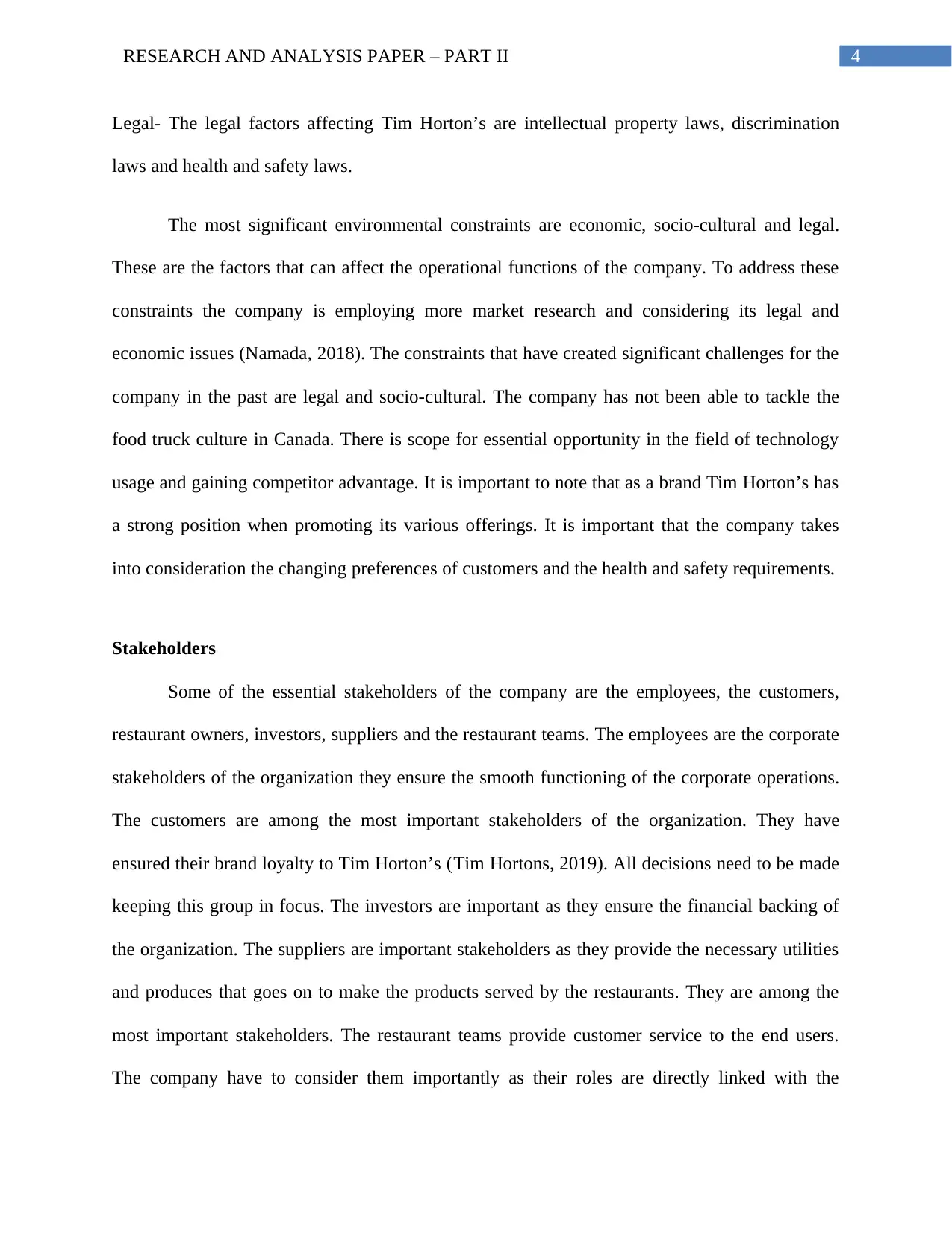
4RESEARCH AND ANALYSIS PAPER – PART II
Legal- The legal factors affecting Tim Horton’s are intellectual property laws, discrimination
laws and health and safety laws.
The most significant environmental constraints are economic, socio-cultural and legal.
These are the factors that can affect the operational functions of the company. To address these
constraints the company is employing more market research and considering its legal and
economic issues (Namada, 2018). The constraints that have created significant challenges for the
company in the past are legal and socio-cultural. The company has not been able to tackle the
food truck culture in Canada. There is scope for essential opportunity in the field of technology
usage and gaining competitor advantage. It is important to note that as a brand Tim Horton’s has
a strong position when promoting its various offerings. It is important that the company takes
into consideration the changing preferences of customers and the health and safety requirements.
Stakeholders
Some of the essential stakeholders of the company are the employees, the customers,
restaurant owners, investors, suppliers and the restaurant teams. The employees are the corporate
stakeholders of the organization they ensure the smooth functioning of the corporate operations.
The customers are among the most important stakeholders of the organization. They have
ensured their brand loyalty to Tim Horton’s (Tim Hortons, 2019). All decisions need to be made
keeping this group in focus. The investors are important as they ensure the financial backing of
the organization. The suppliers are important stakeholders as they provide the necessary utilities
and produces that goes on to make the products served by the restaurants. They are among the
most important stakeholders. The restaurant teams provide customer service to the end users.
The company have to consider them importantly as their roles are directly linked with the
Legal- The legal factors affecting Tim Horton’s are intellectual property laws, discrimination
laws and health and safety laws.
The most significant environmental constraints are economic, socio-cultural and legal.
These are the factors that can affect the operational functions of the company. To address these
constraints the company is employing more market research and considering its legal and
economic issues (Namada, 2018). The constraints that have created significant challenges for the
company in the past are legal and socio-cultural. The company has not been able to tackle the
food truck culture in Canada. There is scope for essential opportunity in the field of technology
usage and gaining competitor advantage. It is important to note that as a brand Tim Horton’s has
a strong position when promoting its various offerings. It is important that the company takes
into consideration the changing preferences of customers and the health and safety requirements.
Stakeholders
Some of the essential stakeholders of the company are the employees, the customers,
restaurant owners, investors, suppliers and the restaurant teams. The employees are the corporate
stakeholders of the organization they ensure the smooth functioning of the corporate operations.
The customers are among the most important stakeholders of the organization. They have
ensured their brand loyalty to Tim Horton’s (Tim Hortons, 2019). All decisions need to be made
keeping this group in focus. The investors are important as they ensure the financial backing of
the organization. The suppliers are important stakeholders as they provide the necessary utilities
and produces that goes on to make the products served by the restaurants. They are among the
most important stakeholders. The restaurant teams provide customer service to the end users.
The company have to consider them importantly as their roles are directly linked with the
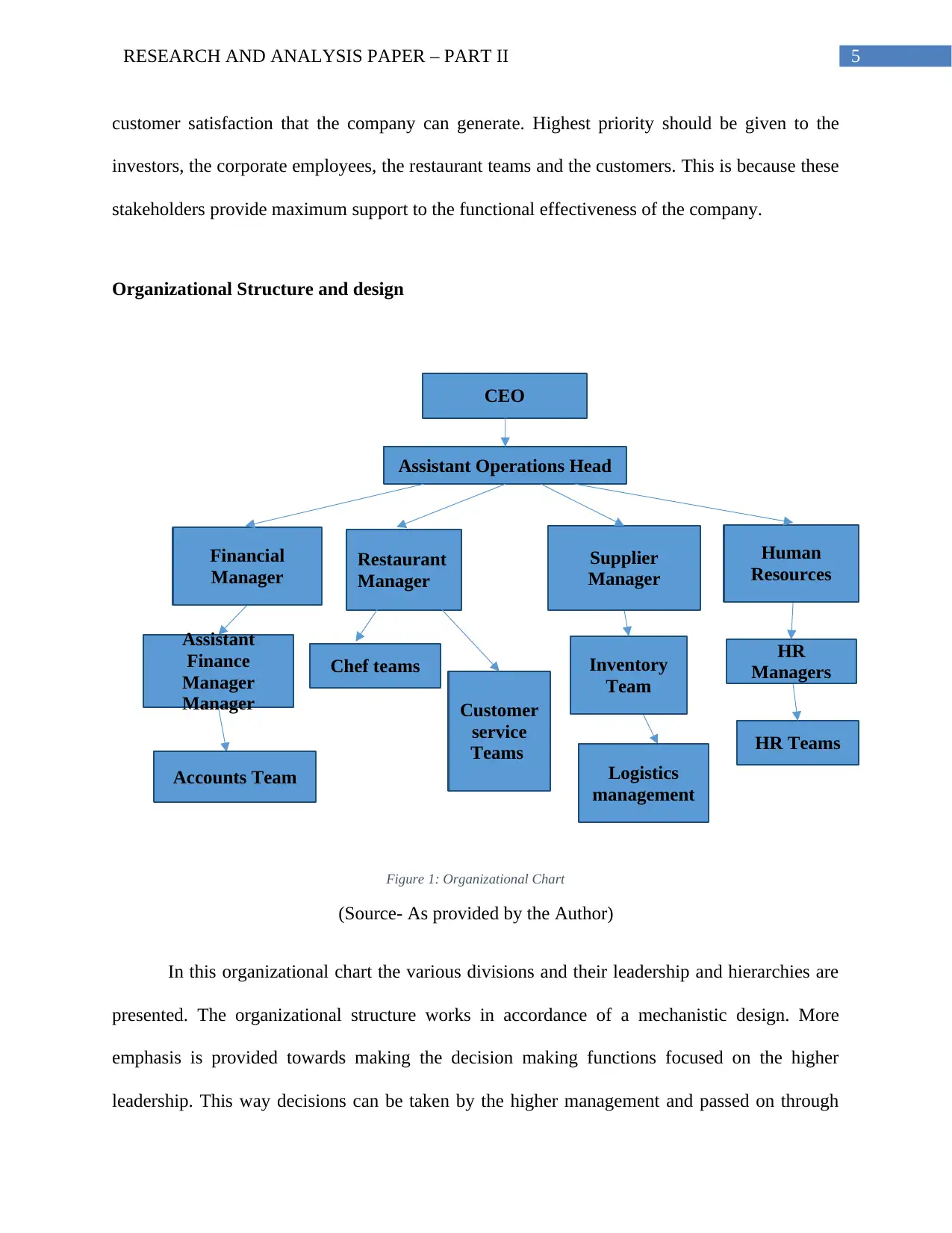
5RESEARCH AND ANALYSIS PAPER – PART II
CEO
Financial
Manager Restaurant
Manager
Supplier
Manager
Human
Resources
Assistant Operations Head
Assistant
Finance
Manager
Manager
Accounts Team
Chef teams
Customer
service
Teams
Inventory
Team
Logistics
management
HR
Managers
HR Teams
customer satisfaction that the company can generate. Highest priority should be given to the
investors, the corporate employees, the restaurant teams and the customers. This is because these
stakeholders provide maximum support to the functional effectiveness of the company.
Organizational Structure and design
Figure 1: Organizational Chart
(Source- As provided by the Author)
In this organizational chart the various divisions and their leadership and hierarchies are
presented. The organizational structure works in accordance of a mechanistic design. More
emphasis is provided towards making the decision making functions focused on the higher
leadership. This way decisions can be taken by the higher management and passed on through
CEO
Financial
Manager Restaurant
Manager
Supplier
Manager
Human
Resources
Assistant Operations Head
Assistant
Finance
Manager
Manager
Accounts Team
Chef teams
Customer
service
Teams
Inventory
Team
Logistics
management
HR
Managers
HR Teams
customer satisfaction that the company can generate. Highest priority should be given to the
investors, the corporate employees, the restaurant teams and the customers. This is because these
stakeholders provide maximum support to the functional effectiveness of the company.
Organizational Structure and design
Figure 1: Organizational Chart
(Source- As provided by the Author)
In this organizational chart the various divisions and their leadership and hierarchies are
presented. The organizational structure works in accordance of a mechanistic design. More
emphasis is provided towards making the decision making functions focused on the higher
leadership. This way decisions can be taken by the higher management and passed on through
⊘ This is a preview!⊘
Do you want full access?
Subscribe today to unlock all pages.

Trusted by 1+ million students worldwide
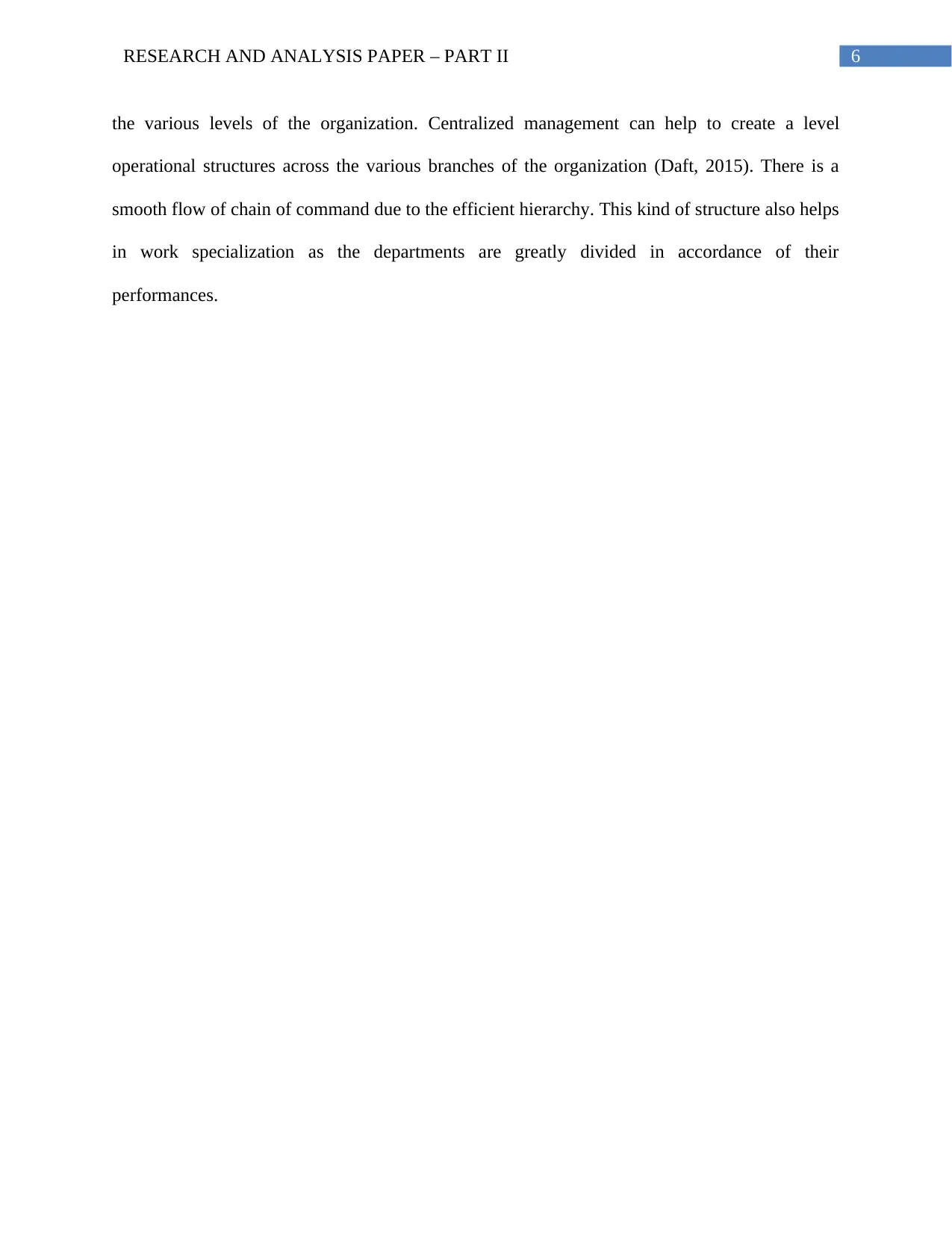
6RESEARCH AND ANALYSIS PAPER – PART II
the various levels of the organization. Centralized management can help to create a level
operational structures across the various branches of the organization (Daft, 2015). There is a
smooth flow of chain of command due to the efficient hierarchy. This kind of structure also helps
in work specialization as the departments are greatly divided in accordance of their
performances.
the various levels of the organization. Centralized management can help to create a level
operational structures across the various branches of the organization (Daft, 2015). There is a
smooth flow of chain of command due to the efficient hierarchy. This kind of structure also helps
in work specialization as the departments are greatly divided in accordance of their
performances.
Paraphrase This Document
Need a fresh take? Get an instant paraphrase of this document with our AI Paraphraser
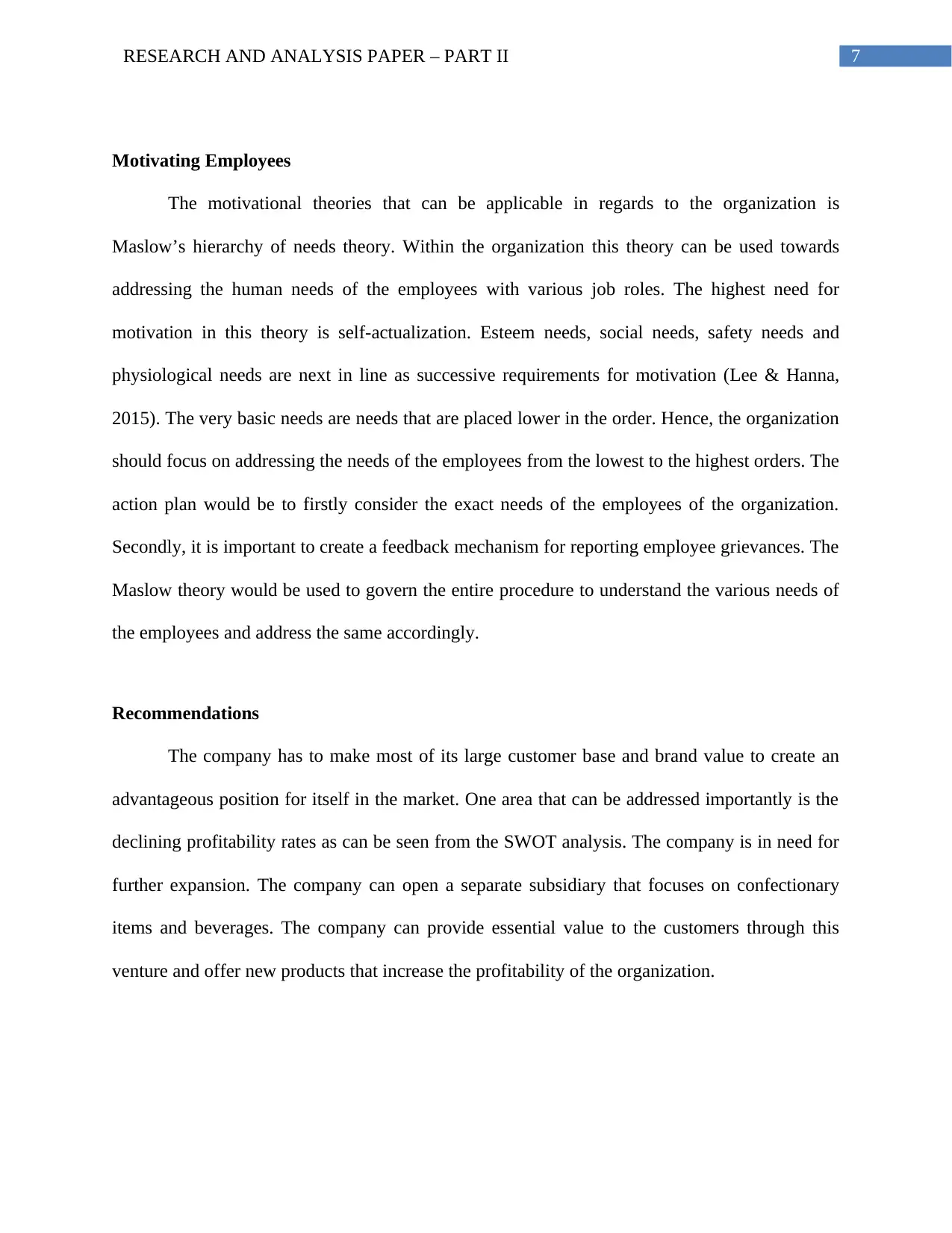
7RESEARCH AND ANALYSIS PAPER – PART II
Motivating Employees
The motivational theories that can be applicable in regards to the organization is
Maslow’s hierarchy of needs theory. Within the organization this theory can be used towards
addressing the human needs of the employees with various job roles. The highest need for
motivation in this theory is self-actualization. Esteem needs, social needs, safety needs and
physiological needs are next in line as successive requirements for motivation (Lee & Hanna,
2015). The very basic needs are needs that are placed lower in the order. Hence, the organization
should focus on addressing the needs of the employees from the lowest to the highest orders. The
action plan would be to firstly consider the exact needs of the employees of the organization.
Secondly, it is important to create a feedback mechanism for reporting employee grievances. The
Maslow theory would be used to govern the entire procedure to understand the various needs of
the employees and address the same accordingly.
Recommendations
The company has to make most of its large customer base and brand value to create an
advantageous position for itself in the market. One area that can be addressed importantly is the
declining profitability rates as can be seen from the SWOT analysis. The company is in need for
further expansion. The company can open a separate subsidiary that focuses on confectionary
items and beverages. The company can provide essential value to the customers through this
venture and offer new products that increase the profitability of the organization.
Motivating Employees
The motivational theories that can be applicable in regards to the organization is
Maslow’s hierarchy of needs theory. Within the organization this theory can be used towards
addressing the human needs of the employees with various job roles. The highest need for
motivation in this theory is self-actualization. Esteem needs, social needs, safety needs and
physiological needs are next in line as successive requirements for motivation (Lee & Hanna,
2015). The very basic needs are needs that are placed lower in the order. Hence, the organization
should focus on addressing the needs of the employees from the lowest to the highest orders. The
action plan would be to firstly consider the exact needs of the employees of the organization.
Secondly, it is important to create a feedback mechanism for reporting employee grievances. The
Maslow theory would be used to govern the entire procedure to understand the various needs of
the employees and address the same accordingly.
Recommendations
The company has to make most of its large customer base and brand value to create an
advantageous position for itself in the market. One area that can be addressed importantly is the
declining profitability rates as can be seen from the SWOT analysis. The company is in need for
further expansion. The company can open a separate subsidiary that focuses on confectionary
items and beverages. The company can provide essential value to the customers through this
venture and offer new products that increase the profitability of the organization.
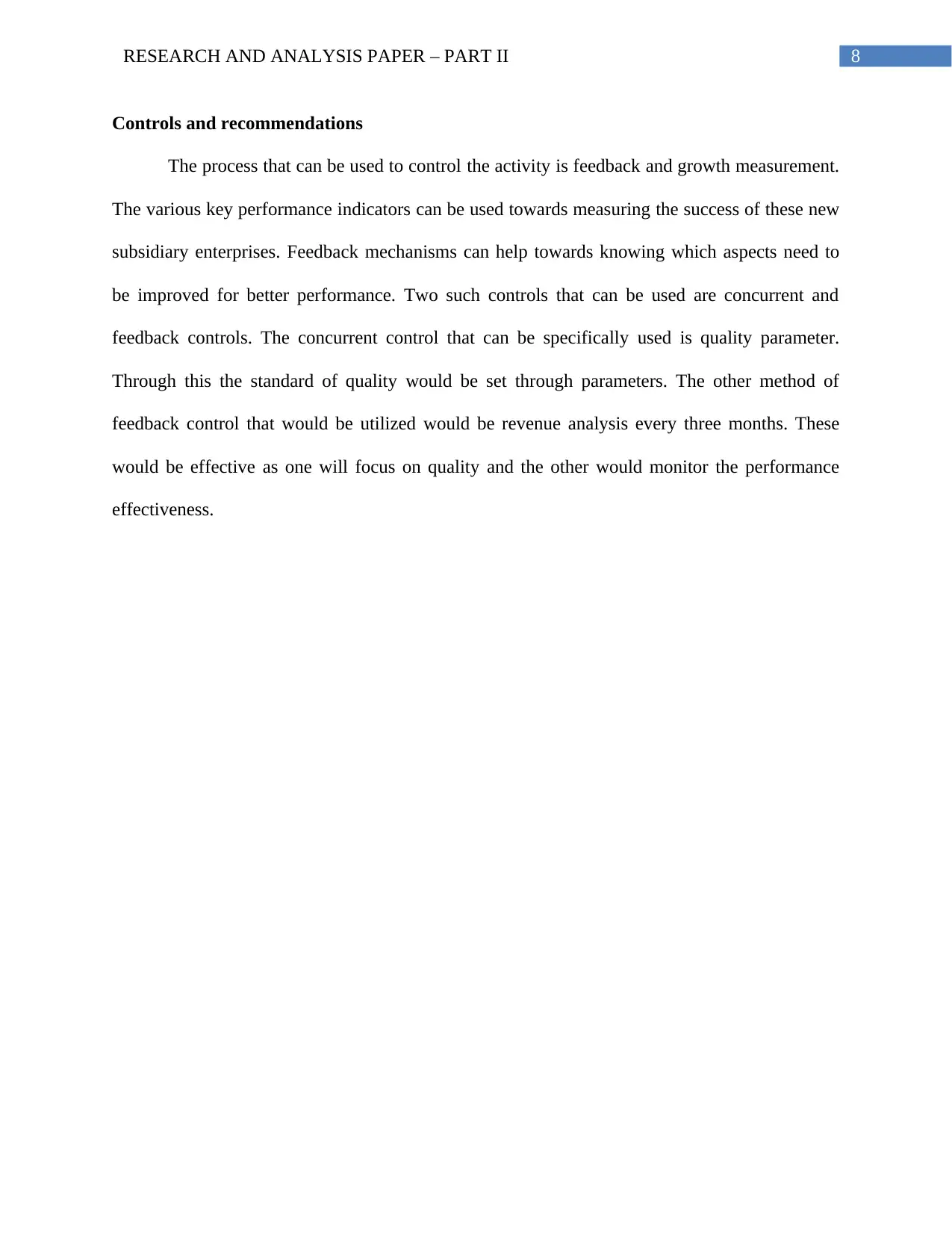
8RESEARCH AND ANALYSIS PAPER – PART II
Controls and recommendations
The process that can be used to control the activity is feedback and growth measurement.
The various key performance indicators can be used towards measuring the success of these new
subsidiary enterprises. Feedback mechanisms can help towards knowing which aspects need to
be improved for better performance. Two such controls that can be used are concurrent and
feedback controls. The concurrent control that can be specifically used is quality parameter.
Through this the standard of quality would be set through parameters. The other method of
feedback control that would be utilized would be revenue analysis every three months. These
would be effective as one will focus on quality and the other would monitor the performance
effectiveness.
Controls and recommendations
The process that can be used to control the activity is feedback and growth measurement.
The various key performance indicators can be used towards measuring the success of these new
subsidiary enterprises. Feedback mechanisms can help towards knowing which aspects need to
be improved for better performance. Two such controls that can be used are concurrent and
feedback controls. The concurrent control that can be specifically used is quality parameter.
Through this the standard of quality would be set through parameters. The other method of
feedback control that would be utilized would be revenue analysis every three months. These
would be effective as one will focus on quality and the other would monitor the performance
effectiveness.
⊘ This is a preview!⊘
Do you want full access?
Subscribe today to unlock all pages.

Trusted by 1+ million students worldwide
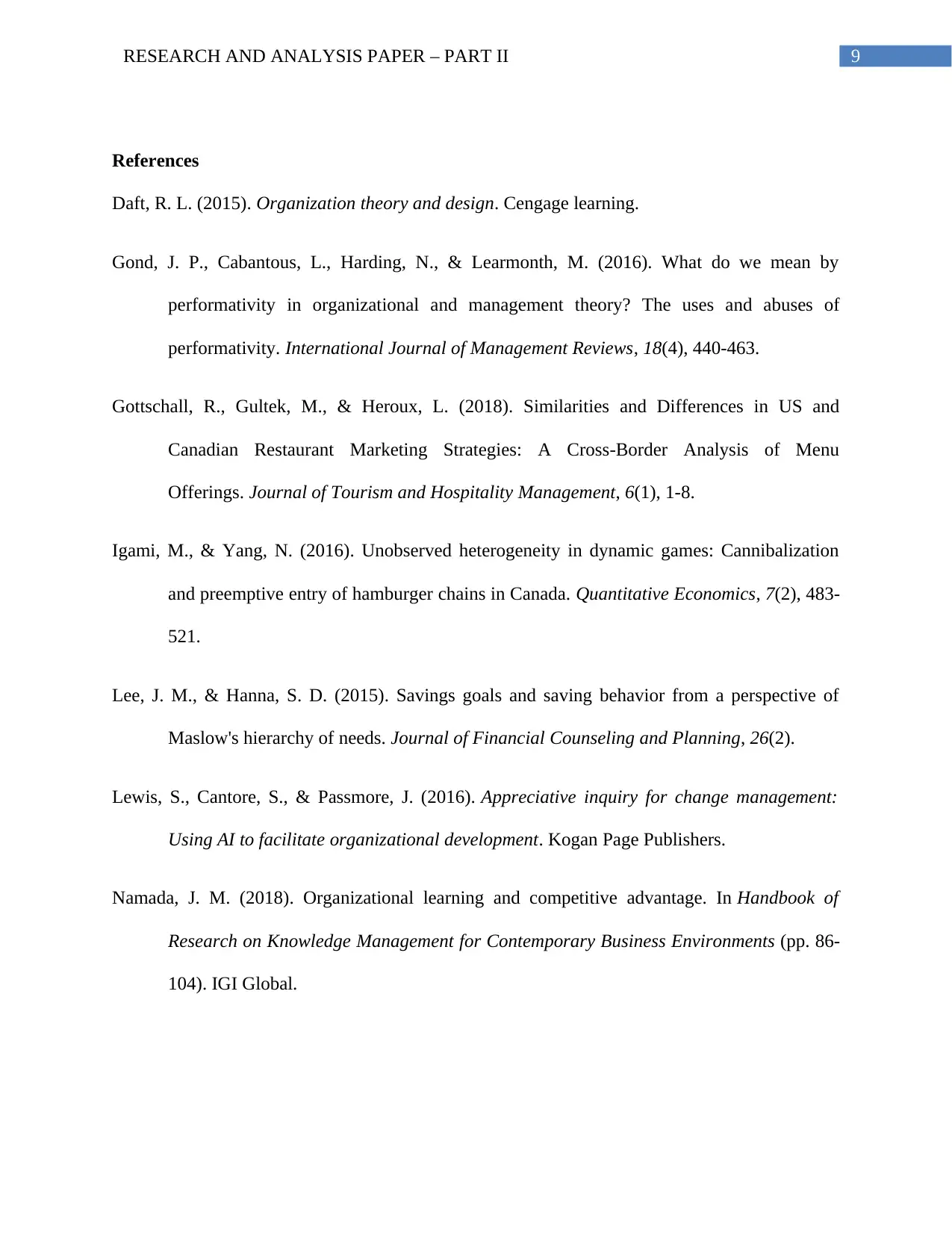
9RESEARCH AND ANALYSIS PAPER – PART II
References
Daft, R. L. (2015). Organization theory and design. Cengage learning.
Gond, J. P., Cabantous, L., Harding, N., & Learmonth, M. (2016). What do we mean by
performativity in organizational and management theory? The uses and abuses of
performativity. International Journal of Management Reviews, 18(4), 440-463.
Gottschall, R., Gultek, M., & Heroux, L. (2018). Similarities and Differences in US and
Canadian Restaurant Marketing Strategies: A Cross-Border Analysis of Menu
Offerings. Journal of Tourism and Hospitality Management, 6(1), 1-8.
Igami, M., & Yang, N. (2016). Unobserved heterogeneity in dynamic games: Cannibalization
and preemptive entry of hamburger chains in Canada. Quantitative Economics, 7(2), 483-
521.
Lee, J. M., & Hanna, S. D. (2015). Savings goals and saving behavior from a perspective of
Maslow's hierarchy of needs. Journal of Financial Counseling and Planning, 26(2).
Lewis, S., Cantore, S., & Passmore, J. (2016). Appreciative inquiry for change management:
Using AI to facilitate organizational development. Kogan Page Publishers.
Namada, J. M. (2018). Organizational learning and competitive advantage. In Handbook of
Research on Knowledge Management for Contemporary Business Environments (pp. 86-
104). IGI Global.
References
Daft, R. L. (2015). Organization theory and design. Cengage learning.
Gond, J. P., Cabantous, L., Harding, N., & Learmonth, M. (2016). What do we mean by
performativity in organizational and management theory? The uses and abuses of
performativity. International Journal of Management Reviews, 18(4), 440-463.
Gottschall, R., Gultek, M., & Heroux, L. (2018). Similarities and Differences in US and
Canadian Restaurant Marketing Strategies: A Cross-Border Analysis of Menu
Offerings. Journal of Tourism and Hospitality Management, 6(1), 1-8.
Igami, M., & Yang, N. (2016). Unobserved heterogeneity in dynamic games: Cannibalization
and preemptive entry of hamburger chains in Canada. Quantitative Economics, 7(2), 483-
521.
Lee, J. M., & Hanna, S. D. (2015). Savings goals and saving behavior from a perspective of
Maslow's hierarchy of needs. Journal of Financial Counseling and Planning, 26(2).
Lewis, S., Cantore, S., & Passmore, J. (2016). Appreciative inquiry for change management:
Using AI to facilitate organizational development. Kogan Page Publishers.
Namada, J. M. (2018). Organizational learning and competitive advantage. In Handbook of
Research on Knowledge Management for Contemporary Business Environments (pp. 86-
104). IGI Global.
Paraphrase This Document
Need a fresh take? Get an instant paraphrase of this document with our AI Paraphraser
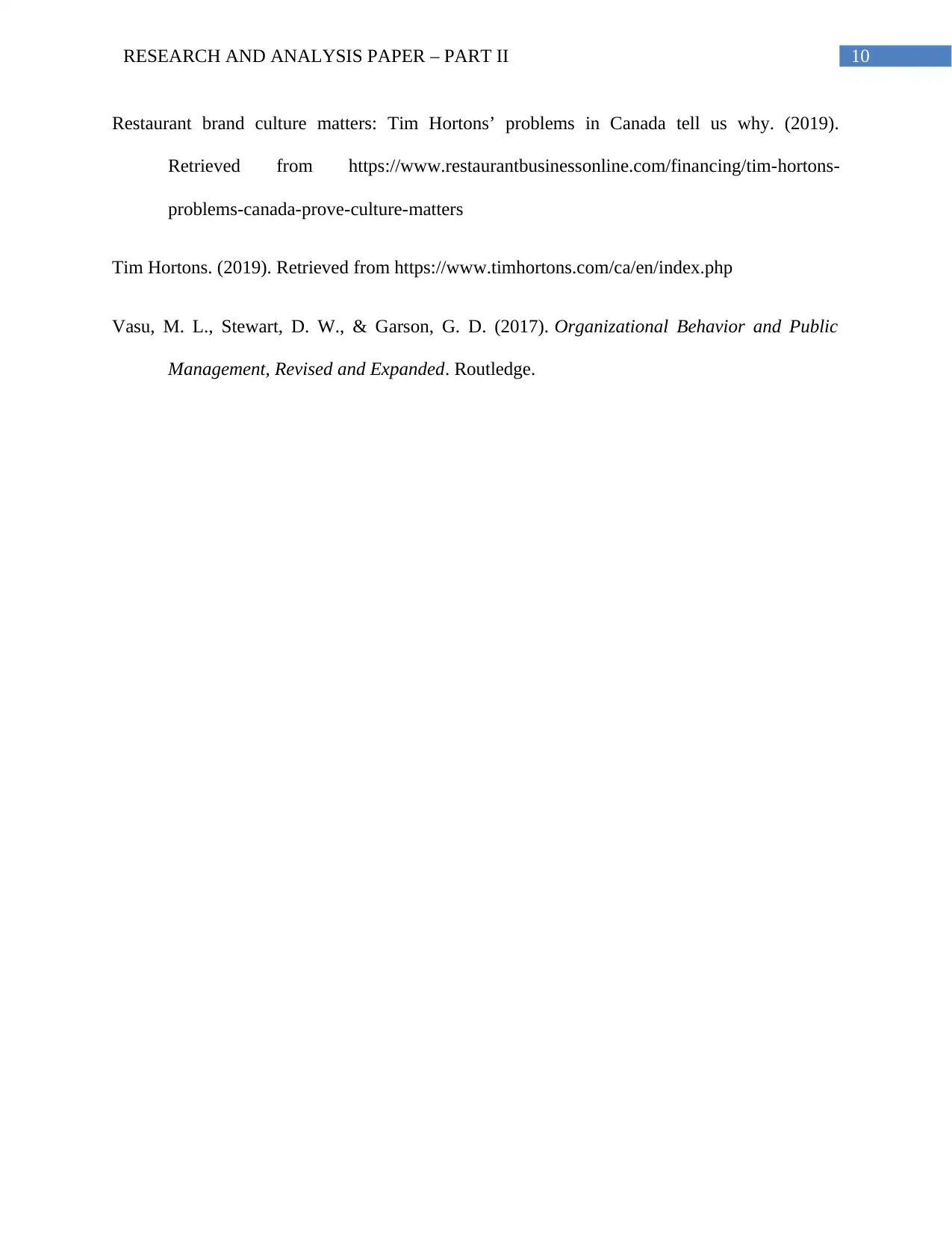
10RESEARCH AND ANALYSIS PAPER – PART II
Restaurant brand culture matters: Tim Hortons’ problems in Canada tell us why. (2019).
Retrieved from https://www.restaurantbusinessonline.com/financing/tim-hortons-
problems-canada-prove-culture-matters
Tim Hortons. (2019). Retrieved from https://www.timhortons.com/ca/en/index.php
Vasu, M. L., Stewart, D. W., & Garson, G. D. (2017). Organizational Behavior and Public
Management, Revised and Expanded. Routledge.
Restaurant brand culture matters: Tim Hortons’ problems in Canada tell us why. (2019).
Retrieved from https://www.restaurantbusinessonline.com/financing/tim-hortons-
problems-canada-prove-culture-matters
Tim Hortons. (2019). Retrieved from https://www.timhortons.com/ca/en/index.php
Vasu, M. L., Stewart, D. W., & Garson, G. D. (2017). Organizational Behavior and Public
Management, Revised and Expanded. Routledge.
1 out of 11
Related Documents
Your All-in-One AI-Powered Toolkit for Academic Success.
+13062052269
info@desklib.com
Available 24*7 on WhatsApp / Email
![[object Object]](/_next/static/media/star-bottom.7253800d.svg)
Unlock your academic potential
Copyright © 2020–2025 A2Z Services. All Rights Reserved. Developed and managed by ZUCOL.



